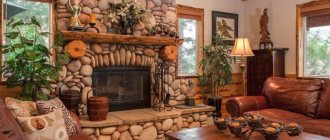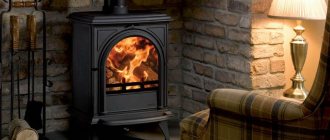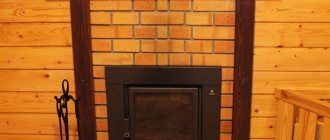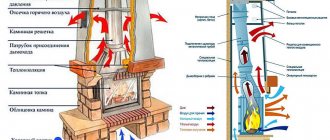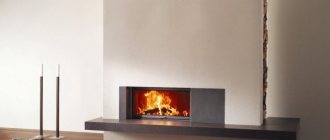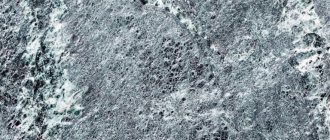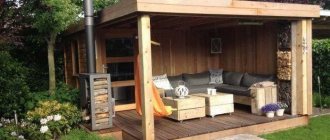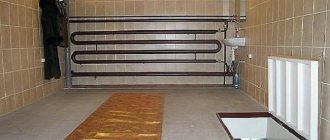Among the popular options for finishing fireplaces, ceramic tiles deserve special attention. Unlike porcelain stoneware and artificial stone, it has high decorative qualities and is suitable for any interior. This decorative element is also somewhat difficult to manufacture and expensive. In order for the tiled fireplace cladding to be an incredible success and become a real decoration of the home, you need to know what it is and how to choose it correctly.
What are tiles
Tiles are called tiles made from baked clay (ceramics). Its main feature is the presence of a bowl on the back - a rump, as well as points for mechanical attachment to the stove or fireplace. In addition, tiles are thicker, and between the back and the fireplace there is enough space for laying broken bricks, sand, and clay to make a kind of thermal cushion.
It is due to the existing attachment points that the tiles are securely held on a specific surface. The mechanical method of fixing the stove to the fireplace allows the brickwork to expand without negative consequences when the temperature rises - heating. The presence of a pump allows you to increase the strength characteristics of tiles and the heat capacity of the fireplace. Its dimensions are somewhat smaller than the area of the product itself.
A tiled fireplace in the house effectively solves problems with heating the room
Advantages of use
Corner fireplaces or standard products lined with tiles bring not only aesthetic pleasure, they have a number of advantages in use, including:
- The efficiency level of the existing fireplace increases by almost 80%.
- Filling the room with heat occurs many times faster.
- It is best to tile a fireplace in a room with a large area and high ceilings.
- Thanks to ceramic products, you can save on the fuel used, because it is consumed less.
- The brickwork receives another level of strengthening, and carbon monoxide does not penetrate into the room.
- The likelihood of cracking of the facing material is minimized.
Good to know: Forged accessories for the fireplace, creating a complete look
Today, finding better material than tiles for the exterior decoration of a stove or fireplace is quite problematic, if not impossible. Thanks to ancient techniques in a modern interpretation, the facing material will serve for decades, while completely maintaining its original appearance and delighting the residents and guests of the house with its warmth.
Advantages of tiles for stoves and fireplaces
Ceramic tiles for facing fireplaces have the following positive characteristics, including:
- High degree of strength and rigidity. It is the thickness of the tile that plays a significant role here; it is 2 times greater than the thickness of ordinary ceramic tiles.
- Resistant to any temperature.
- The ability to “painlessly” respond to any temperature changes.
- Keeps you warm throughout the day.
- No harmful substances. The tiles are absolutely environmentally friendly; during operation and when heated, the baked clay does not emit substances hazardous to human health, and dust does not accumulate on it.
- Does not cause difficulties during care. Just wipe the tiles with a damp cloth and they will shine like new again.
- Economical fuel consumption. Thanks to their box-shaped shape, tiles retain heat for a long time, which reduces fuel consumption. The pump increases the duration of the heating period.
- Low probability of getting burns upon contact with the surface of the fireplace or stove. This is explained by the presence of an internal chamber in the tiles; the outer walls do not have a high temperature.
- Low degree of moisture absorption.
- The heat coming from a fireplace is very similar to that coming from the sun.
- Long service life of the tile.
- Never loses its relevance.
- Beautiful and interesting appearance of finishing material made of refractory clay, to which pure quartz sand has been added.
- Suitable for any style in the room. It is especially effective and advisable to use a fireplace with tiles in country, wooden houses.
Finishing has many advantages, it is devoid of disadvantages
Subtleties of styling
If the owner of the house has made the final decision that a working fireplace will be installed in his room, then the cladding method should be thought about at the stage of creating the project. The bottom line is that ordinary ceramic tiles are light enough, so a standard wall can serve as a base for the stove.
A completed fireplace with tiles will have a fairly large mass (the clay product itself has a lot of weight, plus it is also filled with heavy mortar inside). Accordingly, the wall near which the open hearth will be installed must have additional reinforcement. If this rule is neglected, there is a possibility that in the future the entire structure will gradually deform due to the heavy weight.
Use for finishing white materials
As for the installation technique itself, it is better to entrust this matter to a real professional who has many years of experience working with tiles. This decorative element is made by hand, unlike typical ceramic tiles, which are mass marketed. Accordingly, the cost of such a product is many times higher.
Good to know: What a living room with a fireplace and TV should look like
Going deeper into the installation technique, tiles for stoves and fireplaces (certain rows) must be laid on the surface of the product during the process of its installation. Thus, it turns out that it is necessary to find not just a master who knows how to lay tiles, but a generalist whose skills and knowledge combine the abilities of a stove maker and a tiler.
Types of tiles
There is a wide range of tiles on sale; the variety of designs is simply impressive. The tiles have different room designs and may have artistic painting on them. This unique decor for fireplace cladding is made either without additional processing or has a glazed coating.
Depending on the intended use, the material is produced for decorating walls, cornices, plinths, facades, and corners of buildings. Tiled decor is produced either according to an author's design or using standard technology. There are differences both in the style of painting and in cost.
Advice! It is recommended to choose tiles in accordance with the overall style of the room so that everything looks harmonious.
There are several options for painting unique decor - tiles:
- Yaroslavskaya. Such ornaments are more suitable for rooms where it is necessary to add bright, original elements. The tiles have a large flower with floral patterns around the edges. The paints used here are: white, red, green. There is a thin relief on the surface of the ceramics, which makes the contours of the design more pronounced.
- Gzhelskaya. The motifs on the tiles in this style are made using dark blue and white paint. The blocks mainly depict decorative flowers and leaves. This exquisite, graphic version of painting looks best in the kitchen, bathroom, fireplaces, and stoves.
- Kaluzhskaya. The tiles are distinguished by their rectangular elongated shape, the design is framed, and it is painted in a rich color. Bright plants look impressive against a white background. There are also products that feature landscapes, buildings, and the life of peasants. The painting on the tiles is characterized as simple; pastel shades were chosen for its execution.
- Ant. For images in the style of minimalism, green colors are used, mainly light green and emerald. In contrast to the drawings with a pronounced frame, other elements are decorated in light and dark colors. The decor also contains episodes from peasant life and plants.
- Eastern. The tiles have quite picturesque patterns that are on a blue, brown or green background with a glazed coating. Golden and beige shades are used for floral designs. In addition to flowers, animals and riders can be depicted on the tiles. Small auxiliary elements are performed using a thin brush. The total number of working shades is 2-3.
- Dutch. This block design option is distinguished by its smooth surface; no relief inserts are used here. The decor has complex painting on a white background. The color used in the work is blue, beige, and terracotta. Landscapes and scenes from rural life look beautiful on the tiles.
- Italian. The facing material is made in a simple format, the drawings are quite clear, there is no difficulty in their perception. The floral patterns are designed using orange, green, brick and yellow.
According to the configuration, the tiles can have sides for ease of installation, cells, or an inclined cut. Blocks are produced in square (100×100, 200×200, 220×220 mm), rectangular (205×130 mm), polygonal and round shapes. The sizes of tiles are regulated by GOST 3742-47. The thickness parameters are 45-50 mm. If tiles are made according to an author's design, the dimensions may vary.
The front side of the ceramic can have a textured surface or a smooth one. To produce textured paintings, single-color or multi-component painting is used. Based on the type of surface, tiled tiles are divided into matte and glossy types.
Particularly popular are tiles with an aged surface, finished with gilding and engraving.
Tips for choosing
You must adhere to the following recommendations for choosing this exquisite decor:
- Tiles must be of high quality and have the correct relief.
- If the interior is made in country style, classical or neoclassical, then the use of tiles will have some success. The kitchen apron, stove, and bathroom walls are subject to finishing.
- For a laconic interior, a style of restraint and rigor - minimalism, it is better to use tiles in soothing colors with a relief pattern.
- If there is a need to emphasize the fireplace or stove, then tiles with bright patterns are perfect. The material, made in light colors, without patterns, looks good when finishing large areas. Light glossy tiles can make the room more spacious and comfortable. The main thing is that after installation the reflections of the sun's rays fall on it.
- If the room is made in soothing colors, then you can dilute it with bright tiles with Yaroslavl painting. Tiles with large flowers will look especially harmonious.
- Gzhel tiles in blue and white tones will be relevant for a classic interior, Provence style, and country style. It’s also good to combine it with ceramics in blue, white or light blue.
- For rooms in an elegant, restrained style, it is better to choose tiles with Dutch painting, where all the elements, even the smallest ones, are very well expressed.
The right tiles can make your fireplace a real masterpiece in your home
. Tip!
To enhance the effect, tiles should be combined with surfaces made of wood, natural stone or any suitable ceramics.
Styles of fireplaces with tiles
Making tiles
In their variety, tiled fireplaces are quite practical, this is due to the style directions in which they can be created. This allows you to select and design a stove suitable for a specific interior.
Popular destinations include the following:
- English. Here comes respectable, beautiful tiling with a touch of refined elegance and traditional rich reliefs.
- Rococo from France. Ornaments with reliefs and “golden” painting, which decorate the tiles, will add solemnity to the classic interior.
Tiles in the Rococo style [ads-mob-1][ads-pc-1]
Tiles. Production and differences
- Art Nouveau direction. The cladding is characterized by the presence of volumetric sculptural elements and the painting of complex patterns in different colors. Suitable for interiors decorated in a classic style.
- Fans of light naturalness will appreciate soft patterns with elements containing natural motifs: flowers, leaves, branches. This is a modern style.
- A tiled fireplace, decorated in the Russian style, is distinguished by patterns of geometric shapes, floral elements, excerpts from myths, and tiled tiles can also be painted with various color combinations or landscapes.
When choosing any model for making a stove, it is important to make sure that it will be in harmony with the overall interior of the room.
Cladding the fireplace with tiles
When finishing a heating device, you need to take into account in advance that you will need slightly more working solution than when laying ordinary tiles. In addition, do not forget about the mass of tiled decor. Such calculations must be made even before the base of the fireplace is built; it must withstand a specific load. In addition, when drawing up a fireplace design, you need to take into account the dimensions of the tiles, otherwise, due to the unaccounted thickness, the design will be very different.
High-quality tiles have a bright pattern and clear relief
The tiles should be sorted in advance. Since it is made by hand, there is a high probability of differences in the brightness and expression of the design. Therefore, before starting facing work, it is necessary to lay out the blocks on a flat surface and sort dark products from light ones. If there are any, then it is recommended to lay dark tiles on the lower rows, and light tiles closer to the top of the structure. The dimensions of the finishing material may also vary. In one row there should be tiles with the same height and length.
If there is a need, the tiles can be adjusted to a specific size using a grinder. Stone-cutting machines are also suitable for these purposes; they make it possible not only to make cuts, but also to cool the cut site and cut products of a wide variety of shapes. Upon completion of all cutting operations, the edges on the tiles must be sanded.
Decorating a fireplace with tiles is labor-intensive and requires special attention when laying the first row. The algorithm for covering a fireplace with tiles involves performing the following actions:
- Prepare the tiles. Arrange the tiles according to the pattern and number them. To prevent the tile from drawing moisture from the working solution, it must be soaked in water.
- Fill the pump ½ of the total volume with solution to increase the degree of heat transfer. After this, add gravel or pebbles - they will serve as filler. Fill all available free space with solution.
Important! To lay tiles, it is good to use a mixture of one part clay, two parts quartz sand and two parts brick.
After completing this stage, begin laying the first row:
- First, the corner tiles are installed.
- Then the center of the fireplace is covered with tiles.
To prevent the tiles from slipping, they must be secured with a steel pin. Staples are used to connect horizontal and vertical tiles. The rest of the decorative elements are laid using a similar principle.
DIY fireplace tiles
Before you start making tiles, you need to make a sketch of them, which allows you to calculate the required number of products and their configuration, taking into account the dimensions of the fireplace. After this, the shape of the tile is thought out; the easiest way is to make rectangular or square products. This way they get a slight deviation from the planned dimensions, and it will be much easier to adjust them on site.
DIY fireplace tiles
You need to immediately think about the relief and pattern; this affects the configuration of the template. After this, a mold (template) is prepared, which is used many times, and the remaining clay gradually accumulates in it. For this reason, before each start of work, it is necessary to clean and dry it.
Attention! Even a little dirt in the mold will leave its mark on the front surface.
The mold is filled with clay, do not forget that the material must be added in small portions. You need to start filling the forms from the center, so there will be no air pockets left in it that will spoil the appearance of the tile. The clay is distributed over the entire area; it must be trampled down well with your fingers. This way you will fill all the voids in the template that form the tile pattern.
It is easier for beginners to make smooth products, and only then create a background or design. Cladding a fireplace with tiles can be beautiful, even when finished with smooth tiles.
Preparing clay for tiles
First you need to prepare the clay, it should stand for some time in a soaked state, which can be used to prepare molds.
- Tiles must be made from plastic clay intended for pottery. Strength after firing, ductility and ability to hold shape turns it into an ideal raw material,
- After this, small balls are formed from clay and dried well. Drying takes place in a warm room or outside in summer,
- After drying, the balls are crushed and sifted. You can do this using a fine wire sieve,
- They soak the clay - pour the sifted powder with water, mix the mixture well, and let it settle. After this, the water is carefully drained; during this operation, the bottom layer must not be touched. This will be the clean material needed for work. Any impurities in clay negatively affect the quality of the product. The reason is that the decoration of the fireplace with tiles heats up during the fire, and because of this they slightly increase in volume. Foreign inclusions have a different coefficient of expansion compared to clay, and during heating the tile may crack,
Recommendation. Experts advise cleaning clay this way: make several vertical holes in a container for elutriating clay, and cover them with wooden plugs. As the clay settles, the water above will become lighter. Removing the plugs, gradually drain the light liquid until all the water has drained.
- The prepared clay is dried in the sun, stirring frequently. At the same time, the raw material will become plastic and homogeneous.
Knowledgeable people add additional components to clay - spar, chamotte, kaolin, they give the mixture new properties.
Surface cleaning and grouting
When all installation work is completed, begin cleaning the surface. For these purposes, you should use either paper or a soft napkin.
Soft gypsum dough is perfect for grouting joints. They need to lubricate all seam spaces. The drying time for this grout is 10-15 minutes, after which the excess is removed from the tiles with a rag.
It is not recommended to heat a tiled fireplace immediately after all work; the solution must set well. The optimal amount of time that should pass is one week. The first time the fireplace should not be heated for more than 3 hours. You can use it in full only after 3-4 weeks.
